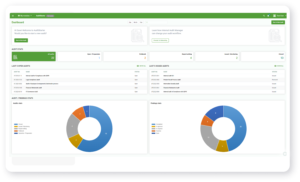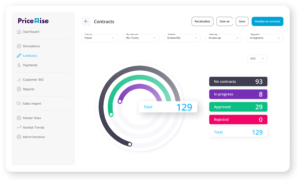- 1. The Data Utilization Gap
- 2. How Data-Driven Market Segmentation Closes the Gap
- 3. Real-World Success: Case Studies in Data-Driven Segmentation
- 4. Case Study 1: Overcoming CRM Adoption Challenges in Life Sciences
- 5. Case Study 2: Transforming Commercial Data in the Animal Health Industry
- 6. Implementing a Data-Driven Market Segmentation Strategy
- 7. Conclusion: From Data Overload to Actionable Insights
Every company wants to be data-driven, and for years, CRM systems have been at the center of that ambition. But here’s the reality: most businesses are sitting on tons of customer data without a clear way to translate it into real business impact. Reports don’t add up, insights remain elusive, and decisions are still made based on intuition. So, what’s missing? The key isn’t just having data — it’s knowing how to use it. That’s where data-driven market segmentation comes in.
For years, companies have poured resources into Customer Relationship Management (CRM) systems, convinced (not without reasons) that collecting customer data would be the key to better decisions and stronger relationships. Today, CRM adoption is widespread, with the market growing from $14 billion in 2010 to over $101 billion in 2024, according to Fortune Business Insights. The same company projects that it will surpass $264 billion by 2032. This is in line with Gartner’s continuous highlights of CRM as the fastest-growing software market.
Yet, despite all these efforts, many organizations still feel let down by their CRM performance. According to Forrester, while CRM systems have been widely implemented, business leaders often struggle to extract tangible business value from them. This dissatisfaction stems not from the technology itself, but from the inability to effectively utilize the data stored within these systems.
The Data Utilization Gap
Businesses gather mountains of data through their CRM platforms, but turning it into something truly useful? That’s another story. Imagine Anna, a regional sales manager at a global manufacturing company. She starts her day by logging into the company’s state-of-the-art CRM, expecting to quickly identify high-value clients at risk of churning. Instead, she spends hours manually extracting data, cross-referencing spreadsheets, and trying to make sense of fragmented customer insights.
Despite millions spent on CRM implementation, the system fails to provide her with clear, actionable intelligence. Meanwhile, the marketing team, unable to access real-time purchasing behavior, continues to push generic campaigns, missing opportunities for personalized engagement.
The result? Despite technically having access to a goldmine of information, Anna and her colleagues are forced to rely on intuition rather than data-driven insights, leading to inefficiencies, missed revenue, and frustrated teams.
Key challenges here include:
- Difficulties with targeting segmented audiences
According to Ascend2’s research, targeting segmented audiences is the single top challenge for data-driven marketing teams (45%). The respondents also pointed to data silos, and lack of centralization (17%). - Outdated or Inaccurate Data
According to Forrester, 25% of data and analytics employees who are dissatisfied with their organization’s data quality estimate that it results in losses exceeding $5 million annually. Additionally, 7% report losses of more than $25 million each year. - Lack of a Clear Analytics Strategy
Without a structured approach, businesses fail to extract meaningful insights from their CRM investments.
How Data-Driven Market Segmentation Closes the Gap
Imagine if Anna had access to a well-structured, data-driven customer segmentation system. Instead of spending hours manually extracting data, she logs into her CRM and immediately sees a dashboard highlighting her highest-risk customers, segmented by churn probability and revenue impact. A predictive AI model flags three key accounts that require urgent attention, and based on past interactions, it suggests tailored retention strategies. With a few clicks, Anna accesses real-time purchasing behavior, enabling her to offer personalized discounts to high-value clients.
Meanwhile, the marketing team no longer pushes generic campaigns. Instead, they leverage data-driven segmentation to send hyper-personalized content tailored to each customer’s past purchases and engagement history.
The result? Higher customer retention, more effective marketing, and a sales team that operates with confidence, using insights rather than intuition.
So, how do we fix this? The answer lies in data-driven market segmentation — a method of categorizing customers based on real data rather than gut feeling.
When done right, segmentation allows businesses to:
- Enhance Customer Targeting
By analyzing behavioral, demographic, and transactional data, companies can create highly personalized marketing campaigns.
- Optimize Sales and Pricing Strategies
Segmenting customers based on their lifetime value (CLV) helps refine pricing models and retention efforts.
- Increase Operational Efficiency
Data segmentation reduces guesswork, allowing marketing and sales teams to focus on high-value opportunities.
Real-World Success: Case Studies in Data-Driven Segmentation
It’s easy to talk about the power of data-driven market segmentation in theory, but the real proof lies in practice. Just look at a few of our implementation case studies, and you’ll see how businesses that once struggled with fragmented CRM data and inefficient targeting transformed their operations.
These cases illustrate not just how companies improved their approach to customer data, but also how the daily work of professionals like Anna became more efficient, strategic, and rewarding. No longer stuck in a cycle of manual data extraction and gut-feel decision-making, they were able to focus on building stronger relationships, closing more deals, and delivering personalized experiences that drive loyalty and revenue.
Case Study 1: Overcoming CRM Adoption Challenges in Life Sciences
A global life sciences company faced severe CRM adoption issues due to inconsistent data and lack of trust in system-generated reports. By implementing a structured data segmentation model, they successfully:
- Localized reporting to align with regulatory differences across markets.
- Eliminated manual data tracking and improved CRM adoption.
- Rebuilt trust in the system, enabling data-driven decision-making.
Before the implementation, if Anna had been working at this company, her daily struggles would have looked familiar—spending hours reconciling inconsistent data, navigating a CRM full of gaps, and dealing with field reps who preferred offline spreadsheets over the official system. Every report was questioned, and decision-making stalled due to a lack of trust in the data.
After implementing a structured data segmentation model, Anna’s experience would be entirely different. Instead of fighting data inconsistencies, she could rely on a CRM that provided clear, localized reporting, aligned with regulatory requirements. Trust in the system was restored, manual work eliminated, and decision-making became faster and more accurate. The CRM was no longer just a database but a true driver of strategic action.
Case Study 2: Transforming Commercial Data in the Animal Health Industry
A leading pharmaceutical firm struggled with data integration after adopting multiple digital solutions. By harmonizing their CRM and market data, they:
- Created a unified source of truth, improving data quality and reporting accuracy.
- Streamlined operations, enabling more effective customer segmentation.
Before the transformation, Anna — if she had been working in this firm — would have faced daily frustrations caused by inconsistent data spread across multiple systems. Sales teams lacked visibility into accurate customer information, leading to redundant efforts and missed opportunities. Marketing campaigns often targeted the wrong audience due to unreliable segmentation, resulting in wasted budget and ineffective messaging.
After the company harmonized its CRM and market data, Anna’s workday would be dramatically different. She could access a unified view of customer interactions, trust the accuracy of reports, and make decisions backed by real insights. Instead of wasting time fixing errors, she could focus on strategic initiatives — optimizing customer segmentation, improving engagement, and driving sales with confidence.
Implementing a Data-Driven Market Segmentation Strategy
Through years of hands-on experience, we’ve honed a clear roadmap for companies that want to get real value out of their CRM data. The right strategy can turn fragmented, underutilized information into actionable insights that enhance sales performance, customer engagement, and marketing precision. The key elements of a successful segmentation strategy include:
- Ensuring Data Quality—standardizing and cleansing CRM data to eliminate errors and duplicates.
- Integrating Data Across Systems—breaking down silos by combining CRM data with external sources like social media, e-commerce, and transactional data.
- Applying AI and Advanced Analytics—using machine learning models to uncover hidden customer patterns and automate segmentation.
- Aligning Segmentation with Business Goals—ensuring that market segmentation strategies directly support revenue growth, customer retention, and operational efficiency.
Conclusion: From Data Overload to Actionable Insights
Gone are the days when CRM was just a digital filing cabinet. Businesses that continue to invest in CRM without an accompanying strategy for data-driven market segmentation risk missing out on the true value of their customer data. By leveraging segmentation techniques and advanced analytics, companies can reap the benefits of market segmentation. They can finally transform their CRM investments into actionable insights, improved customer engagement, and increased revenue.
The question is no longer whether your company has enough data—but whether you’re truly using it to drive results.
Would you like more information about this topic?
Complete the form below.


